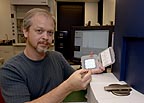July 30, 2007
Chemist wins NSF grant for protein research

Caption follows story
Individual cellular proteins, however, exist in huge numbers and great, evolving variation, which makes unlocking their secrets a real challenge for scientists.
A researcher at Southern Illinois University Carbondale is working on new approaches and equipment that could give accurate and speedy results to scientists trying to identify individual proteins, opening up a variety of applications and potential new discoveries for researchers all over the world.
Gary R. Kinsel, chair of the Department of Chemistry and Biochemistry and an analytical chemist and professor, recently received a three-year, $350,000 grant from the National Science Foundation. The grant will assist Kinsel in developing a new method to study protein expression.
"We hope to develop a platform for the rapid fingerprinting, if you will, of different protein mixtures," Kinsel said. Pre-screening diagnostics for cancer or other cell-based diseases are among the many potential applications for such technology, he said.
At the cellular level, genetic DNA works hand-in-hand with proteins to make the cell work. DNA acts like a blueprint, giving instructions to proteins that carry them out.
There are several effective and proven tools available to scientists who study DNA, Kinsel said. But scientists face many challenges in studying proteins for several reasons.
A major one is known as the "dynamic range problem," which refers to the fact that some proteins are found in great abundance in cells, while others may only exist as two or three molecules. Designing an instrument that will measure both ends of the extreme is like designing a very accurate scale to measure both semi trucks and paper clips.
In addition, not only do cells contain numerous proteins at highly varied levels, the proteins also are constantly changing as they react chemically with other proteins and substances in the cell. This makes the identification process that much more challenging.
"There's no such tool right now for proteins," Kinsel said.
To address these problems, some scientists are developing methods to separate the entire array of proteins present in a cell and then apply traditional methods to measure and study them. So far, this has proven difficult and also time-consuming.
Kinsel's method seeks to cut the overall problem down to size by concentrating on identifying a relatively small number of proteins in a short amount of time using chemistry and mass spectrometry.
Kinsel uses a stainless steel plate of about 42 square inches divided into a grid with different surface chemistries attached as polymer films. Researchers know certain types of proteins will adhere to certain chemistries, such as acids, bases or alcohols, with the other types simply washing away during the application process. This procedure, in effect, separates some proteins from others.
The researcher then can place the plate in a mass spectrometer, blast each spot on the grid with a laser and study the ionized substance this creates to identify what proteins are there.
Kinsel acknowledges his method is a trade-off, eschewing a time-eating overall proteomic analysis in favor of a speedy peek at a fraction of everything. But that approach can be useful in many instances where time is of the essence, such as identifying an environmental contaminant or finding the first hint of disease in a patient. Kinsel estimates a researcher could run the entire analysis in less than an hour.
"We're certainly not going to detect everything and the dynamic range problem is still there, but we will get more insight than if we don't separate the proteins at all and were just looking at a raw sample," Kinsel said. "We're trying to find the balance that gives us enough information to tell us something about a sample, but it doesn't take days to get there."
Researchers can customize the chemical coatings on the plates to test for the presence of different types of proteins, Kinsel said. Other potential applications include homeland defense and environmental monitoring.
The grant will pay the costs associated with investigating and honing these approaches, including what type of chemistry to use on the stainless steel plates and the technical challenges of applying proteins to the plate.
Caption: Mysterious proteins – Gary R. Kinsel, chair of the Department of Chemistry and Biochemistry in the College of Science at Southern Illinois University Carbondale, holds a stainless steel plate he will use to hold proteins inside a mass spectrometer for a research project aimed at developing tools to quickly identify proteins. Kinsel, an analytical chemist and professor, recently received a three-year, $350,000 grant from the National Science Foundation.
Photo by Russell Bailey
